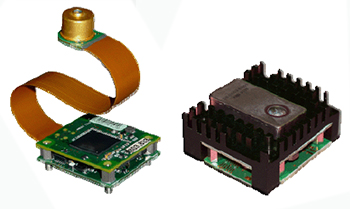
 The 7558A and 7555 Series Rangefinder/Processor assemblies comprise a high performance Model 758A or 755A receiver with compact support electronics to provide corrected range data to a mother system. The serial range data output is calibrated using AMI’s patented technology to mitigate the effects of range errors from various sources including walk due to return signal amplitude variations. Exceptional sensitivity allows the use of low power lasers, or alternatively, long range operation. The modules provide high voltage bias, time programmed gain with noise tracking threshold, first, last, and strongest pulse selection and range gating. The 7558 series offers a TE cooler controller and heatsink. There also are a number of user controlled options via the serial interface. The compact layout allows positioning at the optics for minimum overall system size.
The 7558A and 7555 Series Rangefinder/Processor assemblies comprise a high performance Model 758A or 755A receiver with compact support electronics to provide corrected range data to a mother system. The serial range data output is calibrated using AMI’s patented technology to mitigate the effects of range errors from various sources including walk due to return signal amplitude variations. Exceptional sensitivity allows the use of low power lasers, or alternatively, long range operation. The modules provide high voltage bias, time programmed gain with noise tracking threshold, first, last, and strongest pulse selection and range gating. The 7558 series offers a TE cooler controller and heatsink. There also are a number of user controlled options via the serial interface. The compact layout allows positioning at the optics for minimum overall system size.
Custom options and optimization are available.
- High Sensitivity down to 3 nW (7558 Series)
- Fast Recovery from Overload
- Optimized for Multiple Targets
- Cooled Detector (7558 Series)
- Time Programmed Gain with Noise Tracking Threshold
- High Speed Range Counter
- Range Walk Correction to 1 m RMS
- Digitally adjustable: APD Bias, Range Gates, False Alarm Rate
- Built-in HV Bias Supply for APD Detector
Please visit the catalog page for our Rangefinder Receiver/Processors or contact AMI for additional information.
In the event these commodities will be transferred to a “foreign person” as defined in 22 CFR 120.16,either outside or within the United States, a validated US State Department license is required.

 sales@analogmodules.com
sales@analogmodules.com 1-407-339-4355
1-407-339-4355





 Hybrid eyesafe laser rangefinder receiver is designed for laser rangefinding & surveying equipment. Compact construction is ideal for miniature applications. Fast recovery from T0 overload allows ranging to close objects without compromising long range performance. The incorporation of an InGaAs APD gives very high sensitivity with time programmed gain to minimize false targets. Operation at both 1.06 µm and 1.54 µm is possible over a wide range of pulse widths.
Hybrid eyesafe laser rangefinder receiver is designed for laser rangefinding & surveying equipment. Compact construction is ideal for miniature applications. Fast recovery from T0 overload allows ranging to close objects without compromising long range performance. The incorporation of an InGaAs APD gives very high sensitivity with time programmed gain to minimize false targets. Operation at both 1.06 µm and 1.54 µm is possible over a wide range of pulse widths.
